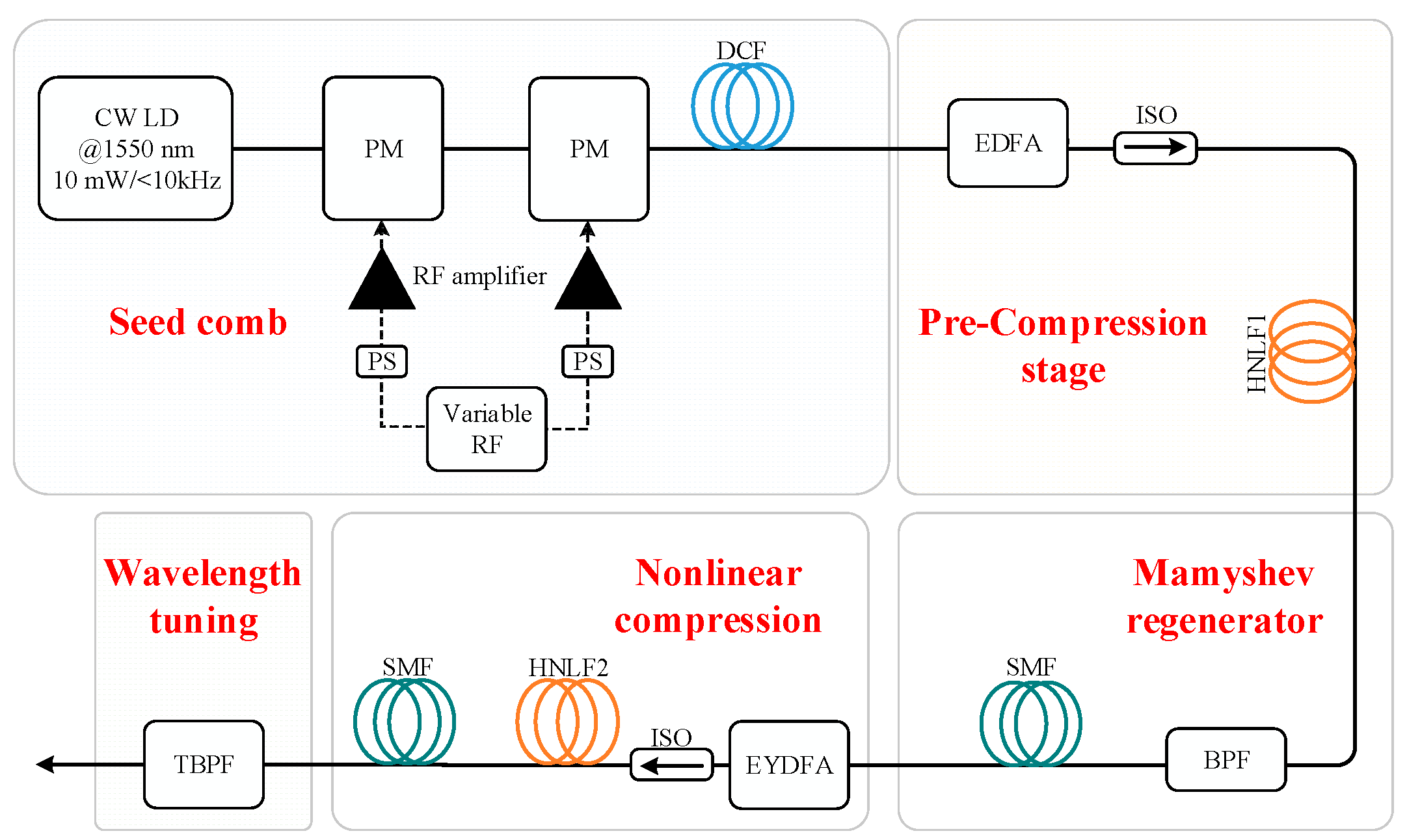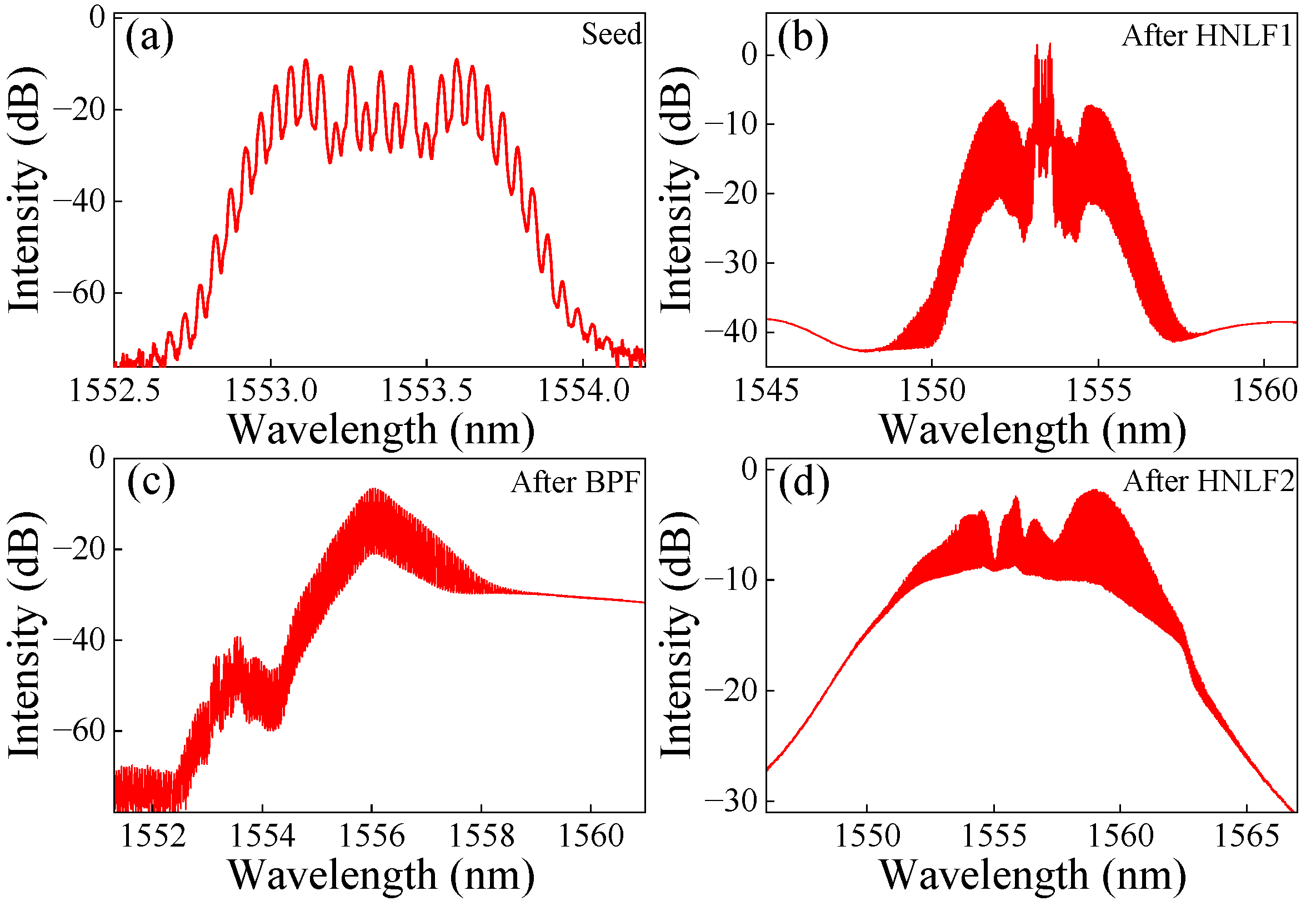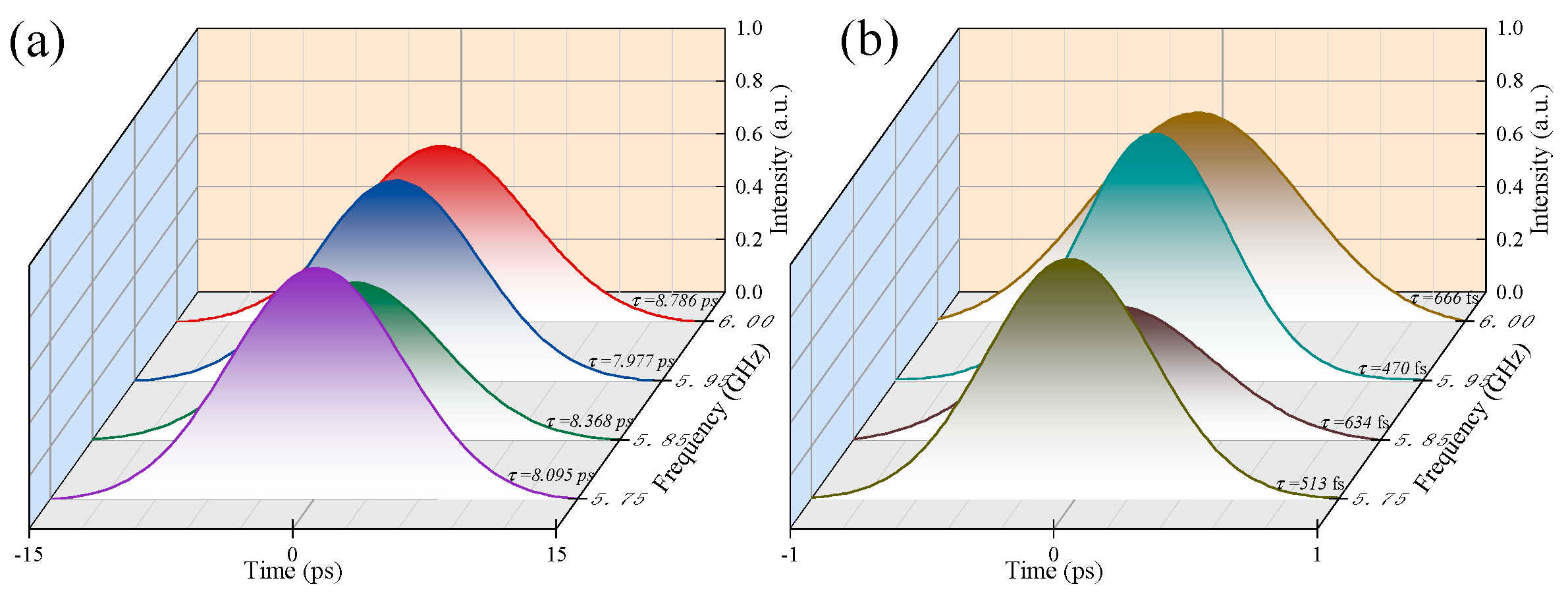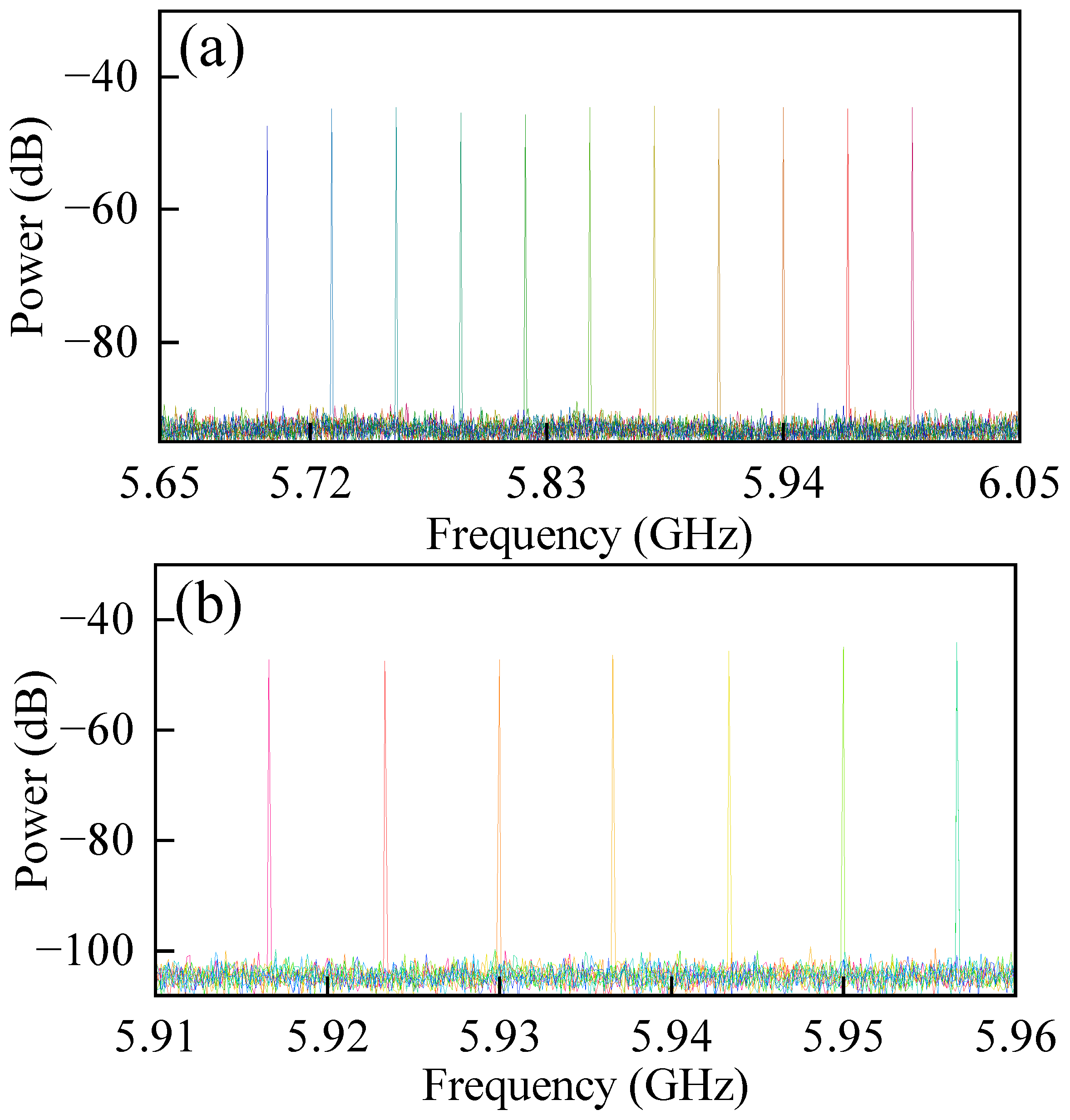Tunable All-Fiber Femtosecond Electro-Optic Optical Frequency Comb Operating at 1.5 μm
Abstract
1. Introduction
2. Experimental Setup
3. Results and Discussion
4. Conclusions
Author Contributions
Funding
Institutional Review Board Statement
Informed Consent Statement
Data Availability Statement
Conflicts of Interest
References
- Hoghooghi, N.; Xing, S.; Chang, P.; Lesko, D.; Lind, A.; Rieker, G.; Diddams, S. Broadband 1-GHz Mid-Infrared Frequency Comb. Light. Sci. Appl. 2022, 11, 264. [Google Scholar] [CrossRef] [PubMed]
- Imrul Kayes, M.; Rochette, M. Fourier Transform Spectroscopy by Repetition Rate Sweeping of a Single Electro-Optic Frequency Comb. Opt. Lett. 2018, 43, 967–970. [Google Scholar] [CrossRef] [PubMed]
- Udem, T.; Holzwarth, R.; Hänsch, T.W. Optical Frequency Metrology. Nature 2002, 416, 233–237. [Google Scholar] [CrossRef]
- Zhang, X.; Zhang, J.; Yin, K.; Li, Y.; Zheng, X.; Jiang, T. Sub-100 Fs All-Fiber Broadband Electro-Optic Optical Frequency Comb at 1.5 Μm. Opt. Express 2020, 28, 34761–34771. [Google Scholar] [CrossRef] [PubMed]
- Zhang, H.; Wu, X.; Jiang, W.; Zhu, S.; Wang, F. A Pulse-Duration Compensation Scheme for GHz Electro-Optic Frequency Comb. IEEE Photon. Technol. Lett. 2024, 36, 1325–1328. [Google Scholar] [CrossRef]
- Ye, H.; Pontagnier, L.; Cormier, E.; Santarelli, G. Multi-Gigahertz Femtosecond Pulses from Linear and Nonlinear Propagation of a Phase-Modulated Laser. Opt. Lett. 2022, 47, 5405–5408. [Google Scholar] [CrossRef]
- Zhang, M.; Buscaino, B.; Wang, C.; Shams-Ansari, A.; Reimer, C.; Zhu, R.; Kahn, J.; Loncar, M. Broadband Electro-Optic Frequency Comb Generation in an Integrated Microring Resonator. Nature 2019, 568, 373–377. [Google Scholar] [CrossRef]
- Cundiff, S.T.; Ye, J. Colloquium: Femtosecond Optical Frequency Combs. Rev. Mod. Phys. 2003, 75, 325–342. [Google Scholar] [CrossRef]
- Gosalia, R.K.; Aguinaldo, R.; Green, J.; Leopardi, H.; Brereton, P.; Malaney, R. Classical and Quantum Frequency Combs for Satellite-Based Clock Synchronization. APL Photonics 2024, 9, 100903. [Google Scholar] [CrossRef]
- Sekhar, P.; Kate Kreider, M.; Fredrick, C.; Ninan, J.P.; Bender, C.F.; Terrien, R.; Mahadevan, S.; Diddams, S.A. Tunable 30 GHz Laser Frequency Comb for Astronomical Spectrograph Characterization and Calibration. Opt. Lett. 2024, 49, 6257–6260. [Google Scholar] [CrossRef]
- Hu, H.; Oxenløwe, L.K. Chip-Based Optical Frequency Combs for High-Capacity Optical Communications. Nanophotonics 2021, 10, 1367–1385. [Google Scholar] [CrossRef]
- Gao, X.; Zhao, Z.; Cong, Z.; Gao, G.; Zhang, A.; Guo, H.; Yao, G.; Liu, Z. Stable 5-GHz Fundamental Repetition Rate Passively SESAM Mode-Locked Er-Doped Silica Fiber Lasers. Opt. Express 2021, 29, 9021–9029. [Google Scholar] [CrossRef] [PubMed]
- Thapa, R.; Nguyen, D.; Zong, J.; Chavez-Pirson, A. All-Fiber Fundamentally Mode-Locked 12 GHz Laser Oscillator Based on an Er/Yb-Doped Phosphate Glass Fiber. Opt. Lett. 2014, 39, 1418–1421. [Google Scholar] [CrossRef]
- Chen, X.; Lin, W.; Wang, W.; Guan, X.; Wen, X.; Qiao, T.; Wei, X.; Yang, Z. High-Power Femtosecond All-Fiber Laser System at 1.5 Μm with a Fundamental Repetition Rate of 4.9 GHz. Opt. Lett. 2021, 46, 1872–1875. [Google Scholar] [CrossRef] [PubMed]
- Barh, A.; Alaydin, B.Ö.; Heidrich, J.; Gaulke, M.; Golling, M.; Phillips, C.R.; Keller, U. High-Power Low-Noise 2-GHz Femtosecond Laser Oscillator at 2.4 Μm. Opt. Express 2022, 30, 5019–5025. [Google Scholar] [CrossRef]
- Aubourg, A.; Lhermite, J.; Hocquet, S.; Cormier, E.; Santarelli, G. Generation of Picosecond Laser Pulses at 1030 Nm with Gigahertz Range Continuously Tunable Repetition Rate. Opt. Lett. 2015, 40, 5610–5613. [Google Scholar] [CrossRef]
- Kadioglu, M.K.; Aslan, B.; Elahi, P. High-Power 120 Fs Pulses at 1.23 GHz from a Single-Mode Er/Yb-Doped Fiber Laser. Appl. Opt. 2024, 63, 9239–9244. [Google Scholar] [CrossRef]
- Yao, B.C.; Rao, Y.J.; Wang, Z.N.; Wu, Y.; Zhou, J.H.; Wu, H.; Fan, M.Q.; Cao, X.L.; Zhang, W.L.; Chen, Y.F.; et al. Graphene Based Widely-Tunable and Singly-Polarized Pulse Generation with Random Fiber Lasers. Sci. Rep. 2015, 5, 18526. [Google Scholar] [CrossRef]
- Ye, H.; Leroi, F.; Pontagnier, L.; Santarelli, G.; Boullet, J.; Cormier, E. High-Power Nonlinear Amplification of an Ultrafast Electro-Optic Frequency Comb with Flexible GHz Repetition Rate. Opt. Express 2022, 30, 10605–10613. [Google Scholar] [CrossRef]
- Carlson, D.R.; Hickstein, D.D.; Zhang, W.; Metcalf, A.J.; Quinlan, F.; Diddams, S.A.; Papp, S.B. An Ultrafast Electro-Optic Light Source with Sub-Cycle Precision. Science 2018, 361, 1358–1363. [Google Scholar] [CrossRef]
- Yang, J.; Zhao, X.; Zhang, L.; Zheng, Z. Single-Cavity Dual-Comb Fiber Lasers and Their Applications. Front. Phys. 2023, 10, 1070284. [Google Scholar] [CrossRef]
- Kikkawa, Y.; Ishizawa, A.; Kou, R.; Xu, X.; Yoshida, K.; Tsuchizawa, T.; Aihara, T.; Nishikawa, T.; Cong, G.; Hitachi, K.; et al. Sub-30-fs Fibre-coupled Electro-optic Modulation Comb at 1.5 Μm with a 25-GHz Repetition Rate. Electron. Lett. 2023, 59, e12830. [Google Scholar] [CrossRef]
- Metcalf, A.J.; Fredrick, C.D.; Diddams, S.A.; Terrien, R.C.; Papp, S.B. 30 GHz Electro-Optic Frequency Comb Spanning 300 THz in the near Infrared and Visible. Opt. Lett. 2019, 44, 2673–2676. [Google Scholar] [CrossRef]
- Deakin, C.; Zhou, Z.; Liu, Z. Phase Noise of Electro-Optic Dual Frequency Combs. Opt. Lett. 2021, 46, 1345–1348. [Google Scholar] [CrossRef] [PubMed]
- Jang, Y.-S.; Park, J.; Jin, J. Comb-Mode Resolved Spectral Domain Interferometer Enabled by a Broadband Electro-Optic Frequency Comb. Photon. Res. 2023, 11, 72–80. [Google Scholar] [CrossRef]
- Metcalf, A.J.; Torres-Company, V.; Leaird, D.E.; Weiner, A.M. High-Power Broadly Tunable Electrooptic Frequency Comb Generator. IEEE J. Select. Top. Quantum Electron. 2013, 19, 231–236. [Google Scholar] [CrossRef]
- Eliason, T.; Parker, P.A.; Reber, M.A.R. Electro-Optic Frequency Comb Generation via Cascaded Modulators Driven at Lower Frequency Harmonics. Opt. Express 2024, 32, 36394–36404. [Google Scholar] [CrossRef]
- Imany, P.; Odele, O.D.; Jaramillo-Villegas, J.A.; Leaird, D.E.; Weiner, A.M. Characterization of Coherent Quantum Frequency Combs Using Electro-Optic Phase Modulation. Phys. Rev. A 2018, 97, 013813. [Google Scholar] [CrossRef]
- Fu, W.; Wright, L.G.; Wise, F.W. High-Power Femtosecond Pulses without a Modelocked Laser. Optica 2017, 4, 831–834. [Google Scholar] [CrossRef]
- Närhi, M.; Fedotov, A.; Aksenova, K.; Fiebrandt, J.; Schönau, T.; Gerecke, M.; Gumenyuk, R. Design Guidelines for Ultrashort Pulse Generation by a Mamyshev Regenerator. Opt. Express 2021, 29, 15699–15710. [Google Scholar] [CrossRef]
- Mamyshev, P.V. All-Optical Data Regeneration Based on Self-Phase Modulation Effect. In Proceedings of the 24th European Conference on Optical Communication, ECOC ’98 (IEEE Cat. No.98TH8398), Madrid, Spain, 20–24 September 1998; Telefonica: Madrid, Spain, 1998; Volume 1, pp. 475–476. [Google Scholar]
- Wang, D.; Huo, L.; Li, Y.; Zhang, D.; Wang, L.; Li, H.; Jiang, X.; Lou, C. Pedestal-Free 25-GHz Subpicosecond Optical Pulse Source for 16 × 25-Gb/s OTDM Based on Phase Modulation and Dual-Stage Nonlinear Compression. Appl. Opt. 2018, 57, 2930–2934. [Google Scholar] [CrossRef] [PubMed]
- Igarashi, K.; Kikuchi, K. Optical Signal Processing by Phase Modulation and Subsequent Spectral Filtering Aiming at Applications to Ultrafast Optical Communication Systems. IEEE J. Select. Topics Quantum Electron. 2008, 14, 551–565. [Google Scholar] [CrossRef]
- Cheng, H.; Chen, K.; Tao, Y.; Shao, W. Dissipative Solitons in Centimeter-Scale Fiber Lasers. J. Light. Technol. 2023, 41, 6779–6785. [Google Scholar] [CrossRef]





Disclaimer/Publisher’s Note: The statements, opinions and data contained in all publications are solely those of the individual author(s) and contributor(s) and not of MDPI and/or the editor(s). MDPI and/or the editor(s) disclaim responsibility for any injury to people or property resulting from any ideas, methods, instructions or products referred to in the content. |
© 2025 by the authors. Licensee MDPI, Basel, Switzerland. This article is an open access article distributed under the terms and conditions of the Creative Commons Attribution (CC BY) license (https://creativecommons.org/licenses/by/4.0/).
Share and Cite
Zhang, A.; Dai, K.; Huang, L.; Sheng, L.; Liu, Z.; Cui, Y.; Hao, X.; Zhang, Y. Tunable All-Fiber Femtosecond Electro-Optic Optical Frequency Comb Operating at 1.5 μm. Photonics 2025, 12, 311. https://doi.org/10.3390/photonics12040311
Zhang A, Dai K, Huang L, Sheng L, Liu Z, Cui Y, Hao X, Zhang Y. Tunable All-Fiber Femtosecond Electro-Optic Optical Frequency Comb Operating at 1.5 μm. Photonics. 2025; 12(4):311. https://doi.org/10.3390/photonics12040311
Chicago/Turabian StyleZhang, Aiguo, Ke Dai, Lin Huang, Liwen Sheng, Zhiming Liu, Yudong Cui, Xiang Hao, and Yusheng Zhang. 2025. "Tunable All-Fiber Femtosecond Electro-Optic Optical Frequency Comb Operating at 1.5 μm" Photonics 12, no. 4: 311. https://doi.org/10.3390/photonics12040311
APA StyleZhang, A., Dai, K., Huang, L., Sheng, L., Liu, Z., Cui, Y., Hao, X., & Zhang, Y. (2025). Tunable All-Fiber Femtosecond Electro-Optic Optical Frequency Comb Operating at 1.5 μm. Photonics, 12(4), 311. https://doi.org/10.3390/photonics12040311




